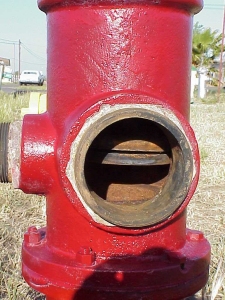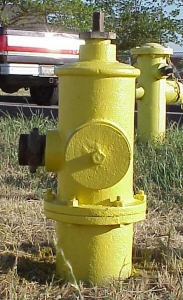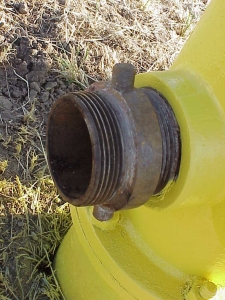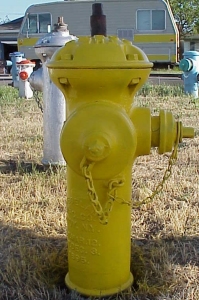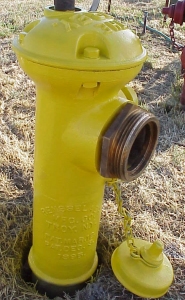
| ||
|
Marysville (CA) Fire Hydrants |
| Photos and Text by Willis Lamm |
|
Marysville presents a classic story of a Spanish colonial trading
post that became a thriving city after the discovery of gold in California. Rapid
population growth and building construction created fire problems with
which the young City had to cope. Marysville boasts the second oldest fire department
in California, organized just after San Francisco, and their fire services were
innovative throughout most of Marysville's history.
CITY HISTORY In 1842 Theodore Cordua leased some grazing land from John A. Sutter and started a trading post near the confluence of the Yuba and Feather rivers. In 1844 he purchased additional land from the Mexican Government. By 1850 the village, then called "Jubaville," had become a major river boat debarkation point for prospectors headed to the gold fields. By this time most of the village's property had changed hands and was owned by four men. In 1850 the four commissioned a survey and the town was officially mapped. It was named after Mary Murphy, a survivor of the ill-fated Donner Party and wife of one of the land owners. By 1853 Marysville boasted substantial brick buildings, mills, foundries, machine shops, factories, schools, churches and two newspapers. By the mid 1850s it was one of the largest cities in California, providing supplies and equipment for miners and shipping millions of dollars worth of gold each year to the US Mint in San Francisco.
|
|
After several serious fires, the City formed a fire brigade in 1866 and acquired a
steam fire engine. Brick lined cisterns were installed at strategic locations from which water
could be drafted, however they tended to leak and were awkward to use. In 1858 the Marysville Water
Company was formed and redwood water mains were installed. The Fire Chief, observing the
equipment being constructed in town for the hydraulic miners, decided to install above
ground fire hydrants. Since the early water system had low water pressure the Chief
specified the hydrants to have 4" outlets so that he could draft from them. Since a large
diameter outlet was a new innovation in the west, there existed no specifications for
thread pitch so the Marysville Foundry created its own pitch, known to this day as "Marysville Thread."
|
Early Marysville hydrant
|
|
The redwood water system did not deliver a great deal of volume. The purpose of the "steamer"
outlet was believed to be for ease of connecting 4 in. hose from the steamer for drafting. As a result there
was little consideration given to flow efficiency through the hydrant valve.
In the first version of the Marysville hydrant, the valve barely made it past the mid point of the steamer outlet when fully open. |
|
|
The greatest peril to the hydraulic mining came from the huge volume of sediment and debris that
the mines discharged into the region's rivers. The infilling of the river beds closed
many rivers to navigation and precipitated flooding during the winter rainy season.
In 1884 a court injunction put an end to most hydraulic mining. By this time Marysville
had become a major agricultural center so the city continued to thrive.
Having plenty of raw materials for and the local foundries looking for work, the Marysville Water Company started installing cast iron water mains. The upgraded system provided increased flows so the second generation Marysville hydrants came with more refined stem guides and valve assemblies which allowed the hydrants to open more completely to take full advantage of available water. |
Conventional packing glands
|
| It is believed that the original hose outlets were iron pipe thread. The bodies had 2½ inch iron pipe female openings into which nipples or adapters of some sort were inserted. In modern times these outlets were adapted to National Hose thread |
|
|
In the mid 1890s the Marysville Foundry packed up and moved to the more industrially active
city of San Francisco. After its leaving, no more Marysville hydrants were produced. Marysville
still needed fire hydrants so they had the Rensselaer Iron Works of Troy, New York produce their
new knuckle valve "Cory" fire hydrant to Marysville's specifications.
Marysville's Cory hydrants were unlike any other that Rensselaer produced, having a 4 in. "Marysville thread" steamer port cast on an even plane with the 2½ in. hose outlet. |
Late 1890's "List-90"
|
| For a number of years fire engines in surrounding communities carried thread adapters with which to connect to Marysville thread hydrants. Nearly 100 years later permanent adapters had been installed on all hydrants that the City intended to keep in service. |
|
Continue to Part 2
|
Unless otherwise noted, all contents of these WWW pages © 1996-2001, FireHydrant.org |

